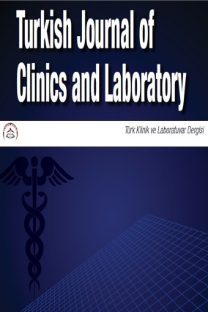Elektif koroner anjiyografi yapılan hastalarda hipomagnezemi ve kontrast ilişkili nefropati riski ilişkisi
Hipomagnezemi, Koroner Anjiyografi, Kontrast Kaynaklı Nefropati
Hypomagnesemia and the risk of contrast-induced nephropathy in patients undergoing elective coronary angiography
___
- 1. McCullough PA. Contrast-induced acute kidney injury. J Am Coll Cardiol. 2008;51(15):1419-28. DOI: 10.1016/j.jacc.2007.12.035
- 2. Nash K, Hafeez A, Hou S. Hospital-acquired renal insufficiency. Am J Kidney Dis. 2002;39(5):930-6. DOI: 10.1053/ajkd.2002.32766
- 3. Martin H, Richert L, Berthelot A. Magnesium deficiency induces apoptosis in primary cultures of rat hepatocytes. J Nutr. 2003;133(8):2505-11. DOI: 10.1093/jn/133.8.2505
- 4. Feng H, Guo L, Gao H, Li XA. The deficiency of calcium and magnesium induces apoptosis via scavenger receptor BI. Life Sci. 2011;88(13-14):606-12. DOI: 10.1016/j.lfs.2011.01.020
- 5. Muñoz-Castañeda JR, Pendón-Ruiz de Mier MV, Rodríguez M, Rodríguez-Ortiz ME. Magnesium Replacement to Protect Cardiovascular and Kidney Damage? Lack of Prospective Clinical Trials. Int J Mol Sci. 2018;19(3). DOI: 10.3390/ijms19030664
- 6. Pere AK, Lindgren L, Tuomainen P, Krogerus L, Rauhala P, Laakso J, et al. Dietary potassium and magnesium supplementation in cyclosporine-induced hypertension and nephrotoxicity. Kidney Int. 2000;58(6):2462-72. DOI: 10.1046/j.1523-1755.2000.00429.x
- 7. Kumar G, Solanki MH, Xue X, Mintz R, Madankumar S, Chatterjee PK, et al. Magnesium improves cisplatin-mediated tumor killing while protecting against cisplatin-induced nephrotoxicity. Am J Physiol Renal Physiol. 2017;313(2):F339-f50. DOI: 10.1152/ajprenal.00688.2016
- 8. Andreucci M, Faga T, Serra R, De Sarro G, Michael A. Update on the renal toxicity of iodinated contrast drugs used in clinical medicine. Drug Healthc Patient Saf. 2017;9:25-37. DOI: 10.2147/DHPS.S122207
- 9. Katholi RE, Woods WT, Jr., Taylor GJ, Deitrick CL, Womack KA, Katholi CR, et al. Oxygen free radicals and contrast nephropathy. Am J Kidney Dis. 1998;32(1):64-71. DOI: 10.1053/ajkd.1998.v32.pm9669426
- 10. Firouzi A, Maadani M, Kiani R, Shakerian F, Sanati HR, Zahedmehr A, et al. Intravenous magnesium sulfate: new method in prevention of contrast-induced nephropathy in primary percutaneous coronary intervention. Int Urol Nephrol. 2015;47(3):521-5. DOI: 10.1007/s11255-014-0890-z
- 11. Rihal CS, Textor SC, Grill DE, Berger PB, Ting HH, Best PJ, et al. Incidence and prognostic importance of acute renal failure after percutaneous coronary intervention. Circulation. 2002;105(19):2259-64. DOI: 10.1161/01.cir.0000016043.87291.33
- 12. Li WH, Li DY, Han F, Xu TD, Zhang YB, Zhu H. Impact of anemia on contrast-induced nephropathy (CIN) in patients undergoing percutaneous coronary interventions. Int Urol Nephrol. 2013;45(4):1065-70. DOI: 10.1007/s11255-012-0340-8
- 13. Altura BM, Altura BT. Vascular smooth muscle and prostaglandins. Fed Proc. 1976;35(12):2360-6. DOI:***
- 14. Altura BM, Altura BT. New perspectives on the role of magnesium in the pathophysiology of the cardiovascular system. II. Experimental aspects. Magnesium. 1985;4(5-6):245-71. DOI:***
- 15. Shechter M, Sharir M, Labrador MJ, Forrester J, Silver B, Bairey Merz CN. Oral magnesium therapy improves endothelial function in patients with coronary artery disease. Circulation. 2000;102(19):2353-8. DOI: 10.1161/01.cir.102.19.2353
- 16. Agus ZS. Hypomagnesemia. J Am Soc Nephrol. 1999;10(7):1616-22. DOI: 10.1681/ASN.V1071616
- ISSN: 2149-8296
- Yayın Aralığı: 4
- Başlangıç: 2010
- Yayıncı: DNT Ortadoğu Yayıncılık AŞ
Akdeniz Diyetinin Atriyal Prematür Kompleks Üzerine Etkileri
Aynur CAMKIRAN FIRAT, Özgür KÖMÜRCÜ, Nilüfer BAYRAKTAR, Atilla SEZGİN, Gülnaz ARSLAN
Mitochondrial Transplantation and Transfer, from past to future expectations
Duygu DAYANIR, Hakan DAYANIR, Serdar GÜNAYDIN
Özgür ALBUZ, Dilek DÜLGER, Gonca ÇABUK, Feray AYDIN
Özlem SARAÇ SANDAL, Ahmet GÖNÜLLÜ, Canem KAVURMA, Gokhan CEYLAN, Gülhan ATAKUL, Pınar SEVEN, Ferhat SARI, Utku KARAARSLAN, Hasan AĞIN
Nail Burak ÖZBEYAZ, Gökhan GÖKALP, Faruk AYDINYILMAZ, Engin ALGUL, Haluk Furkan ŞAHAN, Mehmet Ali FELEKOĞLU, İlkin GULIYEV, Sinan İŞÇEN
Süheyla AYDOĞMUŞ, Aybüke Kevser ABASIYANIK
VARİKOSELEKTOMİ OPERASYONU SONRASI İŞE GERİ DÖNÜŞ ZAMANI VE İŞ GÜNÜ KAYBI
Mehmet Emin ŞİRİN, Mehmet YILMAZ, Mustafa KARAASLAN
Atrial Kitleyi Taklit Eden Spontan İntramural Sol Atrial Hematomun Robot-Asiste Tedavisi
